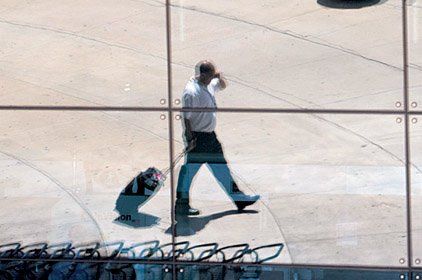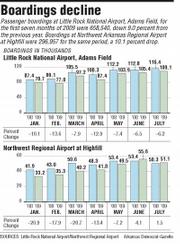LITTLE ROCK — The number of passengers departing and arriving from the state's largest airport has declined nearly 10 percent this year through July, but airport revenue hasn't dropped at the same pace because of increased fees for parking and landings and a leaner budget.
Passenger departures and arrivals at Little Rock National Airport, Adams Field, have dropped 9.62 percent this year compared with 2008, to1,309,775, but income has declined just 1.5 percent through July, to $14,024,788.
"We're doing everything we can to reduce costs and improve the efficiency of the airport and are pleased with the results so far, but not completely satisfied," said Ron Mathieu, the airport's executive director.
Recent months have seen some improvement in passenger traffic. In May, the totals had declined 7.42 percent from the same month a year ago. In June, total passengers declined7.19 percent. In July, there were 8.03 percent fewer than in the previous year.
"The passenger numbers are a little bit higher trending," said Mathieu. "We're optimistic and hopeful they will come back in line."
The decline in passenger traffic remains larger than the national average. Last week, the Air Transport Association of America, the industry trade organization for the leading U.S. airlines, reported that 4 percent fewer passengers traveled on U.S. airlines in July.
But the airlines continue to struggle because of a larger drop in revenue. Passenger revenue based on a sample group of carriers fell 21 percent in July versus the same month in 2008, according to the trade organization. It was the ninth consecutive month in which passenger revenue has fallen from the previous year. Further, the average price to fly one mile fell 18 percent, according to trade organization figures.
Meanwhile, Northwest Arkansas Regional Airport at Highfill reported passenger departures increased in July over a year ago, marking the second consecutive month that more passengers departed from the 10-year-old airport. Passenger traffic dipped 20 percent during the first three months of the year.
"We don't want to call it a trend, but we're feeling better about it," Kelly Johnson, director of Northwest Arkansas Regional, said of the most recent numbers.
Still, the bottom line at airports across the country have been hurt by fewer passengers flying this year.
Last week, the Indianapolis Airport Authority laid off seven employees, including five executives, in a bid to save $650,000 to offset a decrease in airport revenue. The authority, which operates Indianapolis International Airport, also raised parking rates.
The Indianapolis Business Journal reported that the airport faced a budget shortfall because of fewer flights and increased costs associated with a new $1.1 billion terminal that opened a year ago. The airport pays a $40 million mortgage a year, the periodical reported.
Officials at Little Rock National and Northwest Arkansas Regional say they tried to anticipate lower passenger revenue with leaner budgets.
At Little Rock National, expenses totaled $9,929,155 through the first seven months of the year. The expenses were about 10 percent less than what airport officials had budgeted and about 8.6 percent less than what the airport actually spent through the same period in 2008.
Big savings came in cutting back on the number of firefighters stationed at the airport.
In December the Little Rock Municipal Airport Commission voted to reduce the number of firefighters, which came after overtime for firefighters jumped to $246,003 in 2008 - nearly 74 percent higher than the previous year and 93 percent higher than in 2006. While the city employs the firefighters, the airport reimburses the city for the salaries and benefits paid firefighters stationed at the airport.
Under the old arrangement at the airport, the union contract allowed for two of the six firefighters to be off at any one time. If firefighters weren't available to fill in, overtime was used to fill the empty slots. Each time a firefighter was off could result in the need to pay 24 hours of overtime in a given shift and up to 48 overtime hours if two firefighters were off, according to airport officials.
The new policy, which began Jan. 1, calls for having four firefighters stationed at the airport. The staffing level is in line with, and in some cases exceeds, what's done at airports of similar size. Federal Aviation Administration guidelines specify only equipment levels, not staffing levels.
According to the latest figures, the airport has spent $578,989 on firefighters through the first seven months of the year compared to $822,619 for the same period a year ago, a 30 percent decline.
Meanwhile, airport officials have tweaked the revenue side, increasing fees for aircraft landings and car parking.
Rates for commercial service carriers to land at Little Rock National were as low as $2.23 per 1,000 pounds for the first half of 2008, meaning it cost $285.44 each time, for example, a Southwest Airlines Boeing 737 touched down on the airport runway.
In the second half of the year, it cost $3.93 per 1,000 pounds to land because the airport was "correcting for a credit for industrial revenue that the airlines should not have been receiving," said T.J. Williams, the airport spokesman. "We recovered 12 months of shortfall in six months. In addition, airlines had less weight coming in so adjustments were necessary."
Now the rate is at $3.39 per 1,000 pounds, which costs $433.92 for the same Boeing 737 to land.
The airport's agreement with the airlines has expired, but the airport set the landing fees under a Rates by Resolution document that became effective Jan. 1, Williams said.
"Now, airlines are on a month-to-month tenancy so the rates are set outside of a formal agreement until such time as a new contract is put in place," she said. "We are presently in negotiations with the airlines."
With the new rate, the airport has collected $2,749,195 through July compared to $1,999,107, or 3.7 percent.
The airport also offset expected revenue declines by increasing parking fees.
Under the change the commission approved in May, the rates will increase every 20 minutes until the maximum daily rate is reached. Before June 1, the rates for the lots rose in 30-minute increments until the maximum daily rate was reached.
The airport also increased the cost of parking at the airport's 36 parking meters. It now costs 25 cents for five minutes, or $1 for 20 minutes. Before the change, it cost 25 cents for 15 minutes.
At the time, airport officials estimated the adjustments would raise an additional $250,000 a year.
Still, with fewer passengers departing, parking revenue has declined. Through July, the airport collected $4,603,595 in parking revenue, 3.9 percent better than airport officials had budgeted but still $500,112 less than the airport had collected through the same period in 2008.
Airport officials say they will continue to look for ways to save money in the lean times ahead.
"We are aggressively looking at costs and also looking at ways we can take advantage of all revenue opportunities that present themselves," Mathieu said.
Front Section, Pages 1, 2 on 08/25/2009

